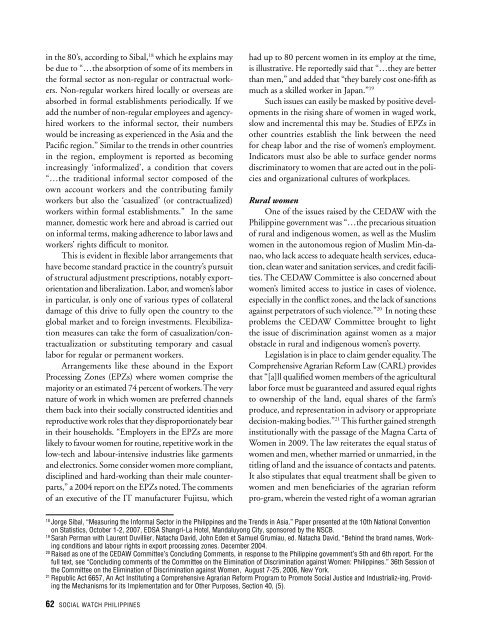Report - Social Watch Philippines
Report - Social Watch Philippines
Report - Social Watch Philippines
You also want an ePaper? Increase the reach of your titles
YUMPU automatically turns print PDFs into web optimized ePapers that Google loves.
in the 80’s, according to Sibal, 18 which he explains may<br />
be due to “…the absorption of some of its members in<br />
the formal sector as non-regular or contractual workers.<br />
Non-regular workers hired locally or overseas are<br />
absorbed in formal establishments periodically. If we<br />
add the number of non-regular employees and agencyhired<br />
workers to the informal sector, their numbers<br />
would be increasing as experienced in the Asia and the<br />
Pacifi c region.” Similar to the trends in other countries<br />
in the region, employment is reported as becoming<br />
increasingly ‘informalized’, a condition that covers<br />
“…the traditional informal sector composed of the<br />
own account workers and the contributing family<br />
workers but also the ‘casualized’ (or contractualized)<br />
workers within formal establishments.” In the same<br />
manner, domestic work here and abroad is carried out<br />
on informal terms, making adherence to labor laws and<br />
workers’ rights diffi cult to monitor.<br />
This is evident in fl exible labor arrangements that<br />
have become standard practice in the country’s pursuit<br />
of structural adjustment prescriptions, notably exportorientation<br />
and liberalization. Labor, and women’s labor<br />
in particular, is only one of various types of collateral<br />
damage of this drive to fully open the country to the<br />
global market and to foreign investments. Flexibilization<br />
measures can take the form of casualization/contractualization<br />
or substituting temporary and casual<br />
labor for regular or permanent workers.<br />
Arrangements like these abound in the Export<br />
Processing Zones (EPZs) where women comprise the<br />
majority or an estimated 74 percent of workers. The very<br />
nature of work in which women are preferred channels<br />
them back into their socially constructed identities and<br />
reproductive work roles that they disproportionately bear<br />
in their households. “Employers in the EPZs are more<br />
likely to favour women for routine, repetitive work in the<br />
low-tech and labour-intensive industries like garments<br />
and electronics. Some consider women more compliant,<br />
disciplined and hard-working than their male counterparts,”<br />
a 2004 report on the EPZs noted. The comments<br />
of an executive of the IT manufacturer Fujitsu, which<br />
62 SOCIAL WATCH PHILIPPINES<br />
had up to 80 percent women in its employ at the time,<br />
is illustrative. He reportedly said that “…they are better<br />
than men,” and added that “they barely cost one-fi fth as<br />
much as a skilled worker in Japan.” 19<br />
Such issues can easily be masked by positive developments<br />
in the rising share of women in waged work,<br />
slow and incremental this may be. Studies of EPZs in<br />
other countries establish the link between the need<br />
for cheap labor and the rise of women’s employment.<br />
Indicators must also be able to surface gender norms<br />
discriminatory to women that are acted out in the policies<br />
and organizational cultures of workplaces.<br />
Rural women<br />
One of the issues raised by the CEDAW with the<br />
Philippine government was “…the precarious situation<br />
of rural and indigenous women, as well as the Muslim<br />
women in the autonomous region of Muslim Min-danao,<br />
who lack access to adequate health services, education,<br />
clean water and sanitation services, and credit facilities.<br />
The CEDAW Committee is also concerned about<br />
women’s limited access to justice in cases of violence,<br />
especially in the confl ict zones, and the lack of sanctions<br />
against perpetrators of such violence.” 20 In noting these<br />
problems the CEDAW Committee brought to light<br />
the issue of discrimination against women as a major<br />
obstacle in rural and indigenous women’s poverty.<br />
Legislation is in place to claim gender equality. The<br />
Comprehensive Agrarian Reform Law (CARL) provides<br />
that “[a]ll qualifi ed women members of the agricultural<br />
labor force must be guaranteed and assured equal rights<br />
to ownership of the land, equal shares of the farm’s<br />
produce, and representation in advisory or appropriate<br />
decision-making bodies.” 21 This further gained strength<br />
institutionally with the passage of the Magna Carta of<br />
Women in 2009. The law reiterates the equal status of<br />
women and men, whether married or unmarried, in the<br />
titling of land and the issuance of contacts and patents.<br />
It also stipulates that equal treatment shall be given to<br />
women and men benefi ciaries of the agrarian reform<br />
pro-gram, wherein the vested right of a woman agrarian<br />
18 Jorge Sibal, “Measuring the Informal Sector in the <strong>Philippines</strong> and the Trends in Asia.” Paper presented at the 10th National Convention<br />
on Statistics, October 1-2, 2007, EDSA Shangri-La Hotel, Mandaluyong City, sponsored by the NSCB.<br />
19 Sarah Perman with Laurent Duvillier, Natacha David, John Eden et Samuel Grumiau, ed. Natacha David, “Behind the brand names, Working<br />
conditions and labour rights in export processing zones. December 2004.<br />
20 Raised as one of the CEDAW Committee’s Concluding Comments, in response to the Philippine government’s 5th and 6th report. For the<br />
full text, see “Concluding comments of the Committee on the Elimination of Discrimination against Women: <strong>Philippines</strong>.” 36th Session of<br />
the Committee on the Elimination of Discrimination against Women, August 7-25, 2006, New York.<br />
21 Republic Act 6657, An Act Instituting a Comprehensive Agrarian Reform Program to Promote <strong>Social</strong> Justice and Industrializ-ing, Providing<br />
the Mechanisms for its Implementation and for Other Purposes, Section 40, (5).


